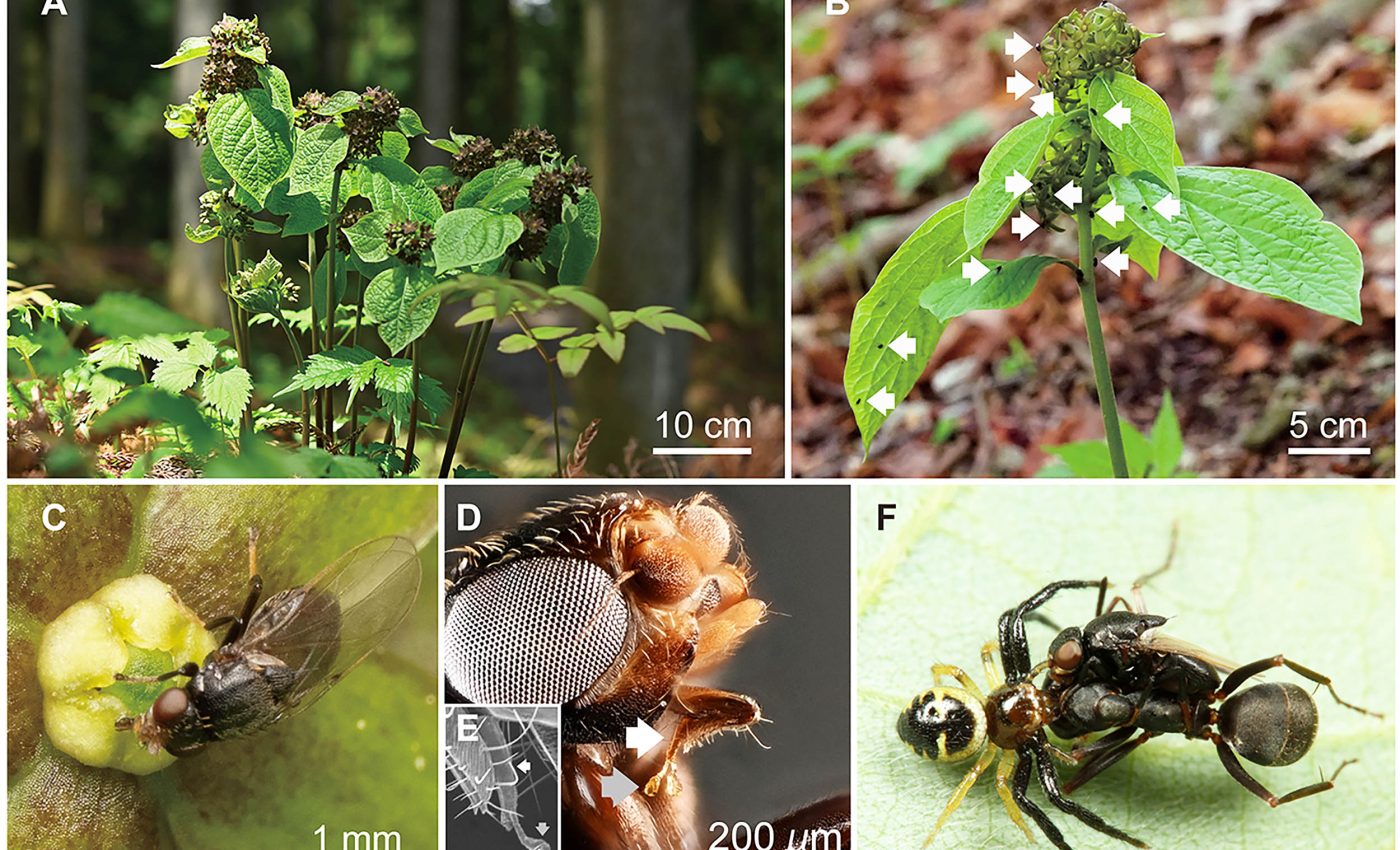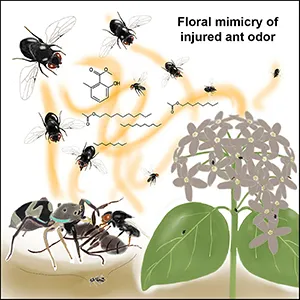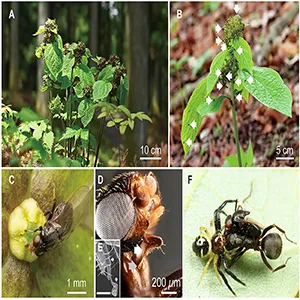
This amazing plant mimics the smell of wounded ants to attract pollinators
A small species of Japanese dogbane plant has learned a neat trick. Its flowers smell like ants that have been attacked and injured, then that odor attracts tiny flies that end up carrying its pollen out into the world to propagate the species.
In a recent study, researchers pinpointed the scented signal to a tight set of chemicals that copy those released by injured ants. This is the first documented case of a plant using ant odor as a lure.
Discovering the Japanese dogbane trick
Ko Mochizuki of the University of Tokyo noticed the odd scene while the plant grew in a botanical garden nursery.
Chloropid flies were swarming the tiny blossoms of Vincetoxicum nakaianum, a member of the Apocynaceae, and would not leave them alone.
“I was working on another research project, and originally collected this species only as a ‘reference’ for comparison,” Mochizuki remembered.
“By chance, I noticed chloropid flies gathering around its flowers in the nursery in the Koishikawa Botanical Gardens, and immediately realized that the flowers might be imitating dead insects.”
The flowers give off a mix of scents that copy what ants smell like when they are attacked by spiders or other predators.
This mix includes some common chemicals, along with two key ingredients called 10Ac and 6-MMS.
Behavior tests showed that these flies were not fooled by just any scent. Two specific components, 10Ac and 6-MMS, were necessary together for attraction, and leaving either one out broke the spell.
Japanese dogbane and chloropid flies
Chloropid flies (Chloropidae) are very small insects with quick movements and sharp appetites.
Many of them are kleptoparasitic, meaning they steal meals from other predators by sipping the body fluids of already injured insects, a behavior documented by classic research.
In the wild, these flies often show up near spiders that have just subdued prey. They are drawn by chemical cues that promise easy calories with low risk.
To check if the scent truly matched injured ants, Mochizuki compared flower odors with emissions from Formica ants after spider attacks. The profiles lined up, and both shared the pair of key compounds tied to fly response.
A Y-maze choice test then let flies pick between different odors. Flies preferred the smell of spider-attacked ants over controls, and they also chose the flower blend when it contained both 10Ac and 6-MMS.
New form of biomimicry
Plants commonly manipulate fly senses by copying signals from carrion, dung, or egg-laying sites.
A broad review shows that this kind of deception, called sapromyiophily, has evolved again and again across unrelated plant groups.
Ants, however, were not known models for floral mimicry until now. This case widens the target list and suggests other hidden systems could be waiting.
Deceptive scents can also mimic alarm cues from other insects. An orchid from China produces a compound that resembles the honey bee alarm pheromone, which brings in hornets that pollinate it.
The Japanese dogbane story follows a similar logic but reaches for a different audience. Instead of hornets, it calls kleptoparasitic flies that expect wounded prey.

Five scents from Japanese dogbane
The flowers consistently gave off five main scent ingredients, including some simple chemicals and a couple of more distinctive ones.
Together, this mix closely matched the smell that ants release when they are under attack.
The fly brain seems to treat the paired presence of 10Ac and 6-MMS as a reliable message. Alone, each compound is not enough to trigger the search behavior.
Field work confirmed that four species of chloropid fly act as pollinators on Vincetoxicum nakaianum. They shuttle between blossoms while tracking the scent that usually means injured ants are nearby.
Pollen transfer comes as a byproduct of their foraging routine. The plant fits into that routine without providing a meal itself.
Ant mimicry among flies
Other studies show that scavenging flies often home in on chemicals from the prey of spiders or plant bugs.
A 2004 paper demonstrated attraction to volatiles from heteropteran scent glands, a cue tied to predation events.
This diet strategy sets up a ready-made channel for plants that can copy the right odors. It also explains why only a precise blend works.
Deception can increase pollen movement without paying the cost of nectar rewards. It can also narrow the pollinator list to a few partners that understand the signal.
Specialization makes a plant vulnerable if those partners decline. It can also stabilize interactions if the signal stays reliable over time.
Why flies respond to injured ants
Vincetoxicum nakaianum plants are native to Japan and were formally described by botanists only recently. The plant grows low, with understated flowers that lean on scent more than showy color.
The family Apocynaceae contains milkweeds and dogbanes known for complex pollination devices. This species adds an olfactory twist that hinges on ant distress cues.
Floral mimicry only works if the receiver has a reason to care. Kleptoparasitic flies care deeply about injured insects because those offer easy access to hemolymph, the insect equivalent of blood.
By tapping into that motivation, the flower wins pollination services. The fly keeps searching for meals as usual.
The discovery hints that ant-based mimicry could be more widespread than records suggest. Many flowers carry faint scents that humans miss, but flies measure them with fine sensitivity.
Field surveys that include chemical profiling can bring these systems to light. Behavioral tests that pair natural cues with synthetic blends can then confirm who is listening.

Japanese dogbane, ants, and biomimicry
The work broadens how we think about models in floral deception. Ants now join carrion, dung, and brood sites as templates plants can use to guide fly behavior.
It also offers a roadmap for bioinspired lures. Simple blends that reuse behaviorally active pheromone components could steer pest or pollinator movement with precision.
“That moment, when I saw the flies on the flowers, was truly one of inspiration, a hypothesis suddenly taking shape. This experience taught me that unexpected discoveries often emerge from a combination of preparation and chance,” said Mochizuki.
Mochizuki plans to compare this dogbane with its close relatives to understand how the ant mimicry trait evolved.
Genetic and ecological data together can test whether the scent blend arose once or more than once within the group.
Comparative studies within Vincetoxicum, and across unrelated lineages, may uncover more odor lookalikes. Each new case can sharpen the rules of floral scent design.
The study is published in Current Biology.
—–
Like what you read? Subscribe to our newsletter for engaging articles, exclusive content, and the latest updates.
Check us out on EarthSnap, a free app brought to you by Eric Ralls and Earth.com.
—–













